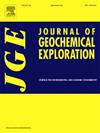伊拉克库尔德斯坦达尔班迪汗水库水和沉积物中微量元素的来源和赋存:人类健康和生态风险评估
IF 3.3
2区 地球科学
Q1 GEOCHEMISTRY & GEOPHYSICS
引用次数: 0
摘要
淡水污染是一个全球性威胁,造成生物多样性下降,同时使水不适于人类饮用。气候变化可能进一步加剧水资源短缺和水质问题。伊拉克被列为易受气候变化影响的国家,预计到2040年将面临严重的水资源压力。伊拉克人口依赖地表水,但其可得性和质量面临若干挑战。这项研究报告了伊拉克库尔德斯坦的一个主要水库达尔班迪汗。48个地点的沉积物、地表水和深水中50多种元素的出现、空间/垂直分布和关联揭示了污染模式,并使人们能够确定几个地质和人为来源,以及建议采取缓解行动的当地富集地区。达尔班迪汗沉积物显示出独特的地质特征,反映了扎格罗斯的地质背景。集水区基性/超基性岩石和矿化的存在导致沉积物中砷、铬和镍含量高,而没有人为来源可以明确区分。元素与地质特征的关联以及深水中较高的浓度表明,底部沉积物是进入上覆水柱的潜在有毒元素的次要来源。相比之下,地表水的组成主要由流入水库的几条溪流的新鲜输入控制。As、Ba、Mo、Ni、Sb、V和Zn的局部富集可追溯到特定的人为排放。用若干指标对污染状况进行的评估表明,大多数场址存在轻度至中度的环境风险和较低的健康风险,但建议在用水方面要谨慎。本文章由计算机程序翻译,如有差异,请以英文原文为准。
Sources and occurrence of trace elements in water and sediments of Darbandikhan reservoir in Iraqi Kurdistan: A human health and ecological risk assessment
Freshwater pollution is a global threat, contributing to the decline in biodiversity whilst making water unsafe for human consumption. Climate change may further aggravate water scarcity and quality. Iraq is ranked as highly vulnerable to climate change and predicted to be extremely water stressed by 2040. Iraqi population relies on surface water, yet its availability and quality face several challenges. This study reports on Darbandikhan, a major water reservoir in Iraqi Kurdistan. The occurrence, spatial/vertical distribution and associations of 50+ elements in sediments, surface and deep water in 48 sites shed light on contamination patterns and enabled identification of several geogenic and anthropogenic sources, and locally enriched areas where mitigation actions are recommended. Darbandikhan sediments revealed a distinctive geogenic signature reflecting the Zagros geological setting. The presence of mafic/ultramafic rocks and mineralisations in the catchment resulted in high levels of As, Cr and Ni in sediments, whilst no anthropogenic sources could be unequivocally discriminated. Elemental associations with a geogenic signature and higher concentrations in deep water suggested that bottom sediments act as a secondary source of potentially toxic elements into the overlying water column. By contrast, surface water composition was primarily controlled by fresh inputs from several streams draining into the reservoir. Local enrichments in As, Ba, Mo, Ni, Sb, V and Zn were traced back to specific anthropogenic discharges. Assessment of the contamination status with several indices suggested mild to moderate environmental risk and low health risk in the majority of sites, although caution in water consumption is advised.
求助全文
通过发布文献求助,成功后即可免费获取论文全文。
去求助
来源期刊

Journal of Geochemical Exploration
地学-地球化学与地球物理
CiteScore
7.40
自引率
7.70%
发文量
148
审稿时长
8.1 months
期刊介绍:
Journal of Geochemical Exploration is mostly dedicated to publication of original studies in exploration and environmental geochemistry and related topics.
Contributions considered of prevalent interest for the journal include researches based on the application of innovative methods to:
define the genesis and the evolution of mineral deposits including transfer of elements in large-scale mineralized areas.
analyze complex systems at the boundaries between bio-geochemistry, metal transport and mineral accumulation.
evaluate effects of historical mining activities on the surface environment.
trace pollutant sources and define their fate and transport models in the near-surface and surface environments involving solid, fluid and aerial matrices.
assess and quantify natural and technogenic radioactivity in the environment.
determine geochemical anomalies and set baseline reference values using compositional data analysis, multivariate statistics and geo-spatial analysis.
assess the impacts of anthropogenic contamination on ecosystems and human health at local and regional scale to prioritize and classify risks through deterministic and stochastic approaches.
Papers dedicated to the presentation of newly developed methods in analytical geochemistry to be applied in the field or in laboratory are also within the topics of interest for the journal.
 求助内容:
求助内容: 应助结果提醒方式:
应助结果提醒方式:


